
from legacy to future ready.
AWS Migration Project
Cloud Elemental enabled Luminus to achieve a faster, more resilient trading platform through automated, scalable AWS solutions, delivering 30% performance gains and reduced downtime.

The Client
Luminus is the second-largest electricity generator and energy provider in Belgium, managing power plants and wind farms while securing external energy sources to ensure a reliable power supply for customers.
Their energy trading platform, Aligne, is essential for making quick, informed trading decisions. However, managing and scaling the platform in on-premises data centers presented significant limitations.
To enhance efficiency and scalability, Cloud Elemental led the migration of Aligne to Amazon Web Services (AWS).
The Challenge
Luminus’s Aligne migration project presented several challenges:

Outdated & Unsupported Application
As a legacy system, Aligne was difficult to maintain and lacked vendor support

No Automation
Manual, tedious processes slowed down operations and increased inefficiencies

Limited Monitoring & Alerts
Lack of real-time insights made issue resolution reactive instead of proactive

Scalability Constraints
On-premise infrastructure couldn’t handle increasing data and demand
Our Approach
We embedded cloud best practices, automation, and up-skilling to drive long-term cloud maturity. Our phased playbook included:

Assessment
- Identify challenges in security, scalability and efficiency
- Evaluate existing infrastructure

Foundations & Security
- Move applications and data securely
- Replatform for improved performance
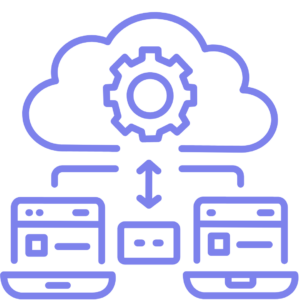
Migration & Optimisation
- Establish connectivity and account structure
- Implement security and compliance safeguards

Scaling & Automation
- Introduce automation and monitoring for efficiency
- Ensure high availability and cost savings
Our Solution
We implemented a highly available, self-healing Cloud architecture using AWS services to ensure the Aligne platform operates with minimal downtime, improved scalability, and robust security.
Here’s how we did it:
Automated Self-Healing Solution
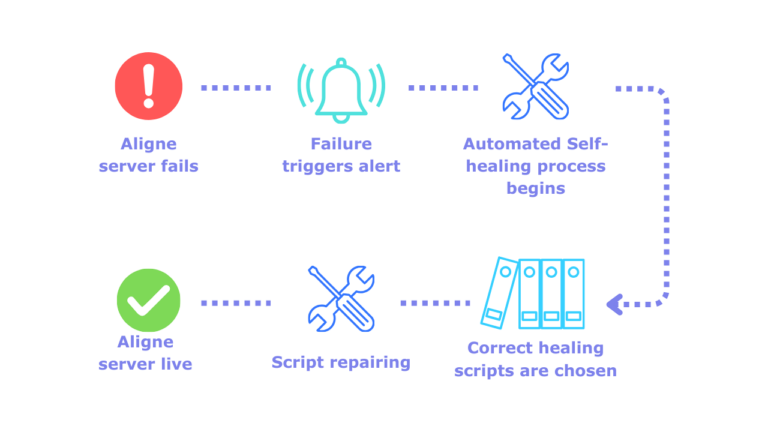
To reduce downtime and enhance reliability, we built a bespoke self-healing mechanism that detects, diagnoses, and recovers from service failures without manual intervention.
- Monitors Aligne, which is made up of over 40 Windows services, identifying failures in real-time
- Triggers automated recovery workflows, ensuring minimal disruption
- Utilises idempotent scripts and AWS infrastructure, allowing for faster issue resolution
- Reduces response times by pinpointing failures precisely and applying corrective actions instantly
Amazon Elastic Load Balancing (ELB)
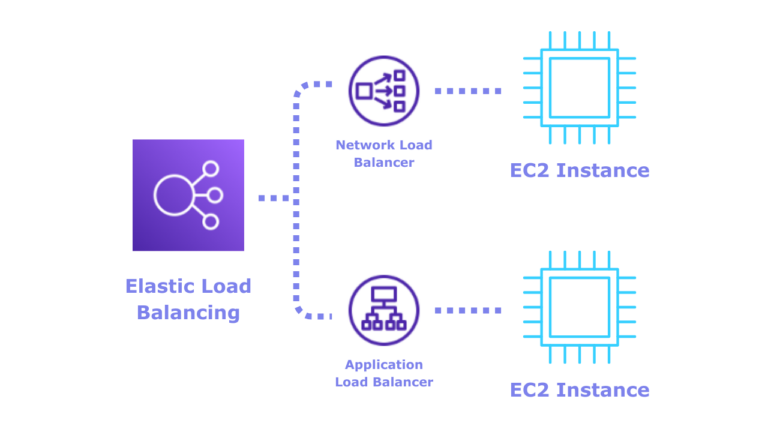
We implemented Elastic Load Balancing (ELB) to route traffic correctly, monitor service health and allow for servers to be swapped out easily where needed. This improves service availability and speeds up recovery from failure.
- Routes traffic across 6 EC2 servers, enhancing scalability and fault tolerance
- Alarms and automation hooks trigger recovery actions if a a service or an EC2/VM/server fails
- Improves security by encrypting traffic in transit
- Reduces infrastructure complexity, making management and scaling easier
Amazon FSx for Windows File Server
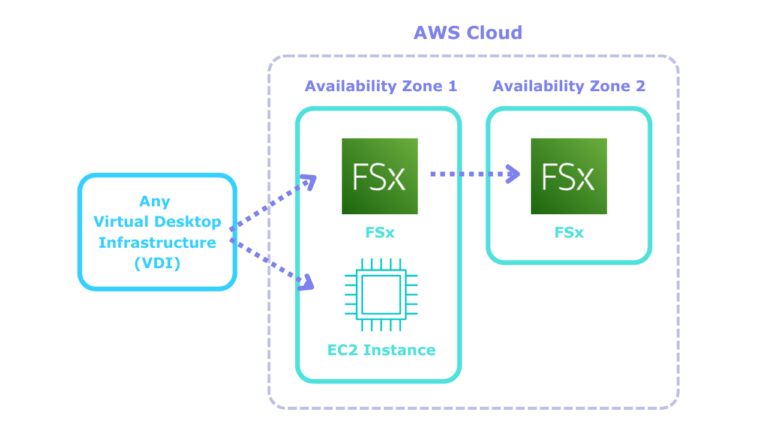
To replace the legacy Windows file server, we introduced Amazon FSx configured for Multi-AZ, ensuring automated failover and backup management for a more resilient storage solution.
- Automated failover, backup, and patching, eliminating manual intervention
- Multi-AZ storage configuration ensures high durability and availability
- Seamlessly integrates with on-premises systems while securing data
- Enhanced security with fine-grained access control via Microsoft Active Directory
AWS Backup & Automated Disaster Recovery
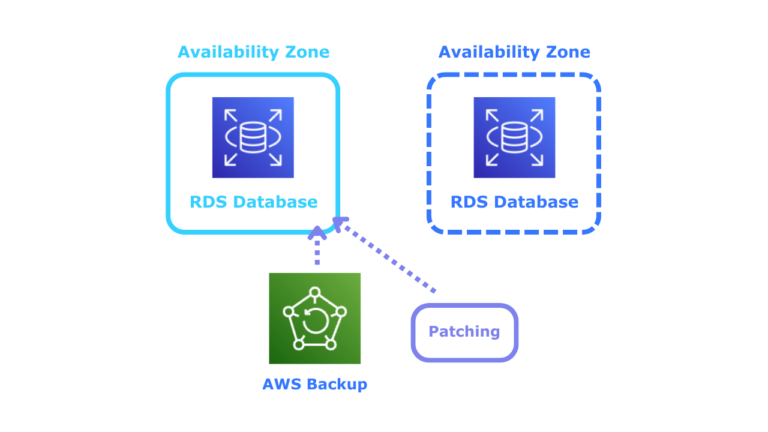
To reduce the risk of data loss and downtime, we deployed AWS Backup for automated data protection and implemented automated disaster recovery processes across multiple environments.
- Automated the workflow to restore an EC2 from any failure, including a complete AZ failure
- Maintains local & remote backup vaults, ensuring disaster recovery readiness
- Reduces downtime with a completely restored EC2 with all application configuration and Active Directory joining complete in under 5 minutes
Amazon RDS
We migrated from on-premises Oracle-on-VM to Amazon RDS Multi-AZ ensuring automatic failover for continuous operations. We developed RDS automation to minimise DBA overhead and limit access to production data.
- Multi-AZ deployment improves database availability and resilience
- On-boarded the Aligne project as the first consumers of the organisational AWS Backup architecture for immutable backups
- Reduced DBA overhead by developing RDS Automation – a workflow to refresh non-production environments with production data without the need to provide any DBA access to production data
Our Results
By migrating Aligne from on-premise to AWS, Luminus has gained greater scalability, enhanced performance, and improved automation capabilities, ensuring their trading platform is more resilient and future-proof. The platform has experienced a 30% increase in performance, with higher data availability and reduced maintenance overhead.

High Availability & Fault Tolerance
- Multi-AZ architecture ensures continuous operations even during infrastructure failures
- Automated failover mechanisms minimise downtime and service disruptions

Resilience & Security
- AWS-native backup and disaster recovery solutions safeguard against unexpected failures
- Strict access control and encryption protect sensitive data and ensure compliance

Automation & Integrated Monitoring
- Automated self-healing workflows proactively resolve application issues
- Logging, security monitoring, and infrastructure automation reduce operational overhead

Scalability & Elasticity
- Load balancing and compute optimisation ensure smooth operations under varying workloads
Ready to transform your Cloud infrastructure?
Cloud solutions, simplified.
Let's discuss how we can help you achieve your Cloud goals with our expertise and proven methodology.


from legacy to future ready.
AWS Migration Project
Cloud Elemental enabled Luminus to achieve a faster, more resilient trading platform through automated, scalable AWS solutions, delivering 30% performance gains and reduced downtime.
The Client

Luminus is the second-largest electricity generator and energy provider in Belgium, managing power plants and wind farms while securing external energy sources to ensure a reliable power supply for customers.
Their energy trading platform, Aligne, is essential for making quick, informed trading decisions. However, managing and scaling the platform in on-premises data centers presented significant limitations.
To enhance efficiency and scalability, Cloud Elemental led the migration of Aligne to Amazon Web Services (AWS).
The Challenge
Luminus’s Aligne migration project presented several challenges:

Outdated & Unsupported Application
As a legacy system, Aligne was difficult to maintain and lacked vendor support

No Automation
Manual, tedious processes slowed down operations and increased inefficiencies

Limited Monitoring & Alerts
Lack of real-time insights made issue resolution reactive instead of proactive

Scalability Constraints
On-premise infrastructure couldn’t handle increasing data and demand
Our Approach
We embedded cloud best practices, automation, and up-skilling to drive long-term cloud maturity. Our phased playbook included:

Assessment
- Identify challenges in security, scalability and efficiency
- Evaluate existing infrastructure

Foundations & Security
- Move applications and data securely
- Replatform for improved performance
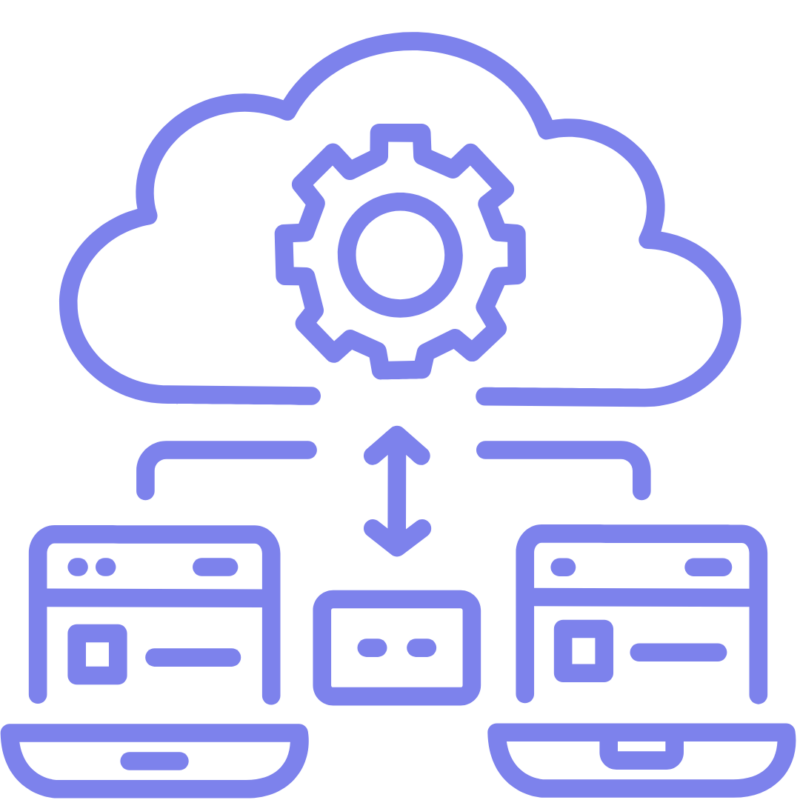
Migration & Optimisation
- Establish connectivity and account structure
- Implement security and compliance safeguards

Scalability & Automation
- Introduce automation and monitoring for efficiency
- Ensure high availability and cost savings
Our Solution
We implemented a highly available, self-healing Cloud architecture using AWS services to ensure the Aligne platform operates with minimal downtime, improved scalability, and robust security.
Here’s how we did it:
To reduce downtime and enhance reliability, we built a bespoke self-healing mechanism that detects, diagnoses, and recovers from service failures without manual intervention.

- Monitors Aligne, which is made up of over 40 Windows services, identifying failures in real-time
- Triggers automated recovery workflows, ensuring minimal disruption
- Utilises idempotent scripts and AWS infrastructure, allowing for faster issue resolution
- Reduces response times by pinpointing failures precisely and applying corrective actions instantly
We implemented Elastic Load Balancing (ELB) to route traffic correctly, monitor service health and allow for servers to be swapped out easily where needed. This improves service availability and speeds up recovery from failure.

- Routes traffic across 6 EC2 servers, enhancing scalability and fault tolerance
- Alarms and automation hooks trigger recovery actions if a a service or an EC2/VM/server fails
- Improves security by encrypting traffic in transit
- Reduces infrastructure complexity, making management and scaling easier
To replace the legacy Windows file server, we introduced Amazon FSx configured for Multi-AZ, ensuring automated failover and backup management for a more resilient storage solution.

- Automated failover, backup, and patching, eliminating manual intervention
- Multi-AZ storage configuration ensures high durability and availability
- Seamlessly integrates with on-premises systems while securing data
- Enhanced security with fine-grained access control via Microsoft Active Directory
To reduce the risk of data loss and downtime, we deployed AWS Backup for automated data protection and implemented automated disaster recovery processes across multiple environments.

- Automated the workflow to restore an EC2 from any failure, including a complete AZ failure
- Maintains local & remote backup vaults, ensuring disaster recovery readiness
- Reduces downtime with a completely restored EC2 with all application configuration and Active Directory joining complete in under 5 minutes
We migrated from on-premises Oracle-on-VM to Amazon RDS Multi-AZ ensuring automatic failover for continuous operations. We developed RDS automation to minimise DBA overhead and limit access to production data.

- Multi-AZ deployment improves database availability and resilience
- On-boarded the Aligne project as the first consumers of the organisational AWS Backup architecture for immutable backups
- Reduced DBA overhead by developing RDS Automation – a workflow to refresh non-production environments with production data without the need to provide any DBA access to production data
Our Results
By migrating Aligne from on-premise to AWS, Luminus has gained greater scalability, enhanced performance, and improved automation capabilities, ensuring their trading platform is more resilient and future-proof.
The platform has experienced a 30% increase in performance, with higher data availability and reduced maintenance overhead.

High Availability & Fault Tolerance
- Multi-AZ architecture ensures continuous operations even during infrastructure failures
- Automated failover mechanisms minimise downtime and service disruptions

Resilience & Security
- AWS-native backup and disaster recovery solutions safeguard against unexpected failures
- Strict access control and encryption protect sensitive data and ensure compliance

Automation & Integrated Monitoring
- Automated self-healing workflows proactively resolve application issues
- Logging, security monitoring and infrastructure automation reduce operational overhead

Scalability & Elasticity
- Load balancing and compute optimisation ensure smooth operations under varying workloads

Ready to transform your Cloud Infrastructure?
Let’s discuss how we can help you achieve your Cloud goals with our expertise and proven methodology.